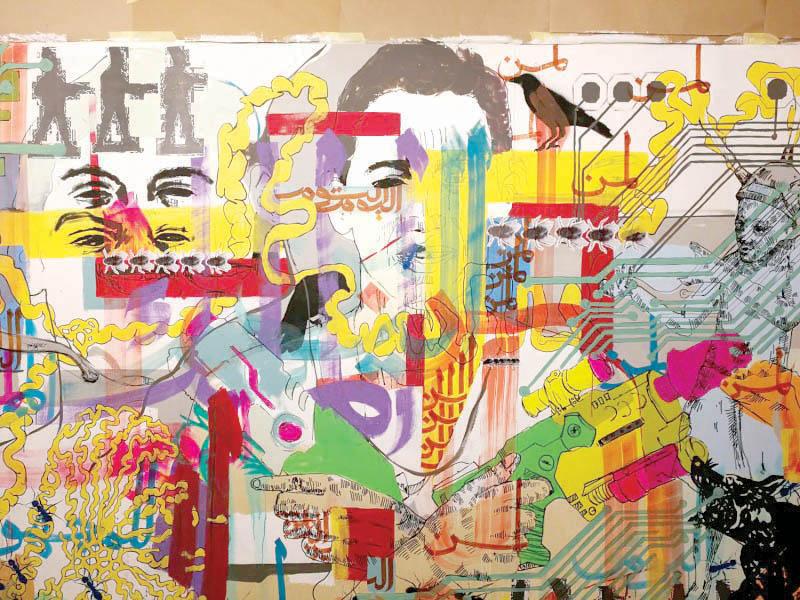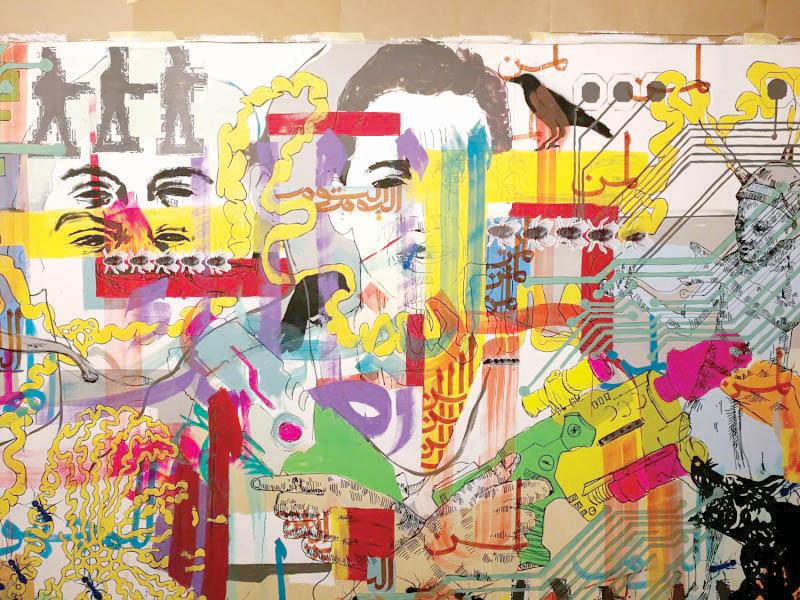Graffiti goes indoors in Egypt
CAIRO - In a room no larger than 20 sq.metres, graffiti loses its populist garb as street art for all to see in bright sunlight and becomes prisoner of private showrooms, seen only by patrons under artificial lighting.
The first graffito to make the trip from the street to an art gallery was a mural commemorating the fourth anniversary of the drowning of Hisham Rezk, a former student at the Faculty of Art. It was exhibited in July at the Mashrabia Gallery of Contemporary Art in Cairo as part of an exhibition titled “Trader of Simplicity.”
The mural was meant to be a tribute to the disappeared by Rezk’s friends but it seems their brushes went out of control and tackled political and social aspects.
Rezk belonged to the first generation of young street artists in Egypt, the self-proclaimed Revolutionary Artists Union. Rezk created an independent group and presented several black humour street shows, beginning with the “Art is a Street” initiative in Cairo’s Abdeen Square. The artist’s goal was to “bring a smile to the average people,” hence the nickname “Trader of Simplicity” given to him by his comrades.
Wild graffiti became extremely popular in Egypt seven years ago. It was a mixture of plastic arts, caricature and cartoons and became a form of political opposition.
The exhibition at Mashrabia Gallery included previous works by Rezk and his friends but they were all eclipsed by the giant mural. There were also blank pieces, a commentary on the issue of freedom.
Twenty artists from different artistic and political backgrounds participated in the exhibition. They were united by their commitment to freedom of expression. There were no preconditions on their participation in the mural and each contributed freely. The result was a rich piece that oozed candour and spontaneity.
As usual, the contributing artists did not sign the mural. They wanted to commemorate Rezk with an unsigned piece. On his Facebook page however, they published this quote by Rezk: “I will stay long-haired, shabby and wearing old shoes to lose all those who care only about my appearance and keep only those who care about my essence.”
Unlike most murals during the golden age of graffiti art in Egypt (2011-13), the commemorative mural did not bear political slogans. At first glance, it looked like a composition of different paintings and photographs dealing with a diversity of topics. On closer examination, many hidden political messages popped up.
Representations of animals were prominent. All of them had dark and unpleasant symbolism in popular culture. There were pessimistic crows, a police dog ready to attack and an army of ants crawling without a sense of direction or purpose, an allusion to Egyptian youth.
At the centre of the mural, two giant hands held a machine gun and a revolver. More messages could be found in selected Quranic verses reproduced in the mural.
Artists at the exhibition refused to give their names because their work was a collective effort. They said the mural was “experimental” and aimed at supporting independent art and opening the gates to new generations of creators with no shackles or strings attached.
The artists said the streets have become unwelcoming spaces for politically and socially aware graffiti. Only murals representing nature or geometric shapes are allowed.
Art students are often exploited to produce these murals or to paint the walls of some institutions for free. Of course, the paint companies that donated the paint don’t miss the opportunities for free publicity by placing their names on the murals.
Throughout Egypt’s post-revolutionary phase, graffiti developed a humorous and satirical quality and played a prominent role in political criticism. Subsequent governments, however, view graffiti artists as “a bunch of teenagers” who vandalise and deface walls and scribble offensive tags. Graffiti is not seen as a legitimate expression of freedom but is criminalised as libel and defamation.
Mohammed Mahmoud Street, facing the former headquarters of the Ministry of Interior, was the largest site for graffiti artwork demanding the restoration of civilian rule during the transitional period. The district has cleared away all street art in the neighbourhood, including Rezk’s last piece, as well as a mural painted in his memory by Ammar Abu Bakr on the wall of the American University in Cairo.
The graffiti artists at the exhibition said they see the socio-political climate as propitious for new murals. The problem is the shrinking room for freedom of expression. Some said they hoped they would be able to return to the streets; others said they wanted to stay in galleries and hoped they wouldn’t be banned from those spaces as well.
In reaction to political interpretations of their work, the artists smile. “It’s an open piece of work. Everyone has a right to read it as they see it and form their own interpretation,” they said.
Muhamad Abdul Hadi is an Egyptian writer.
This article was originally published in The Arab Weekly.






